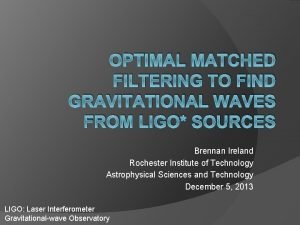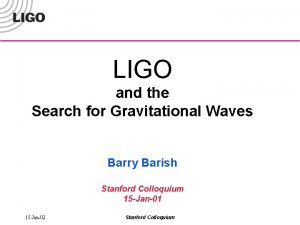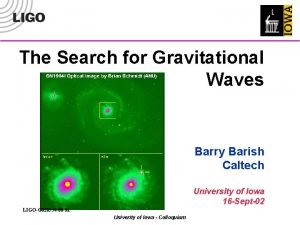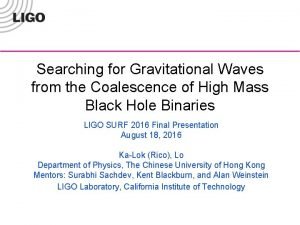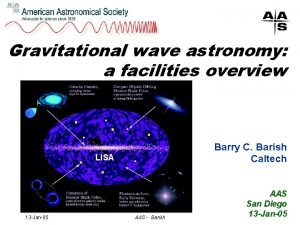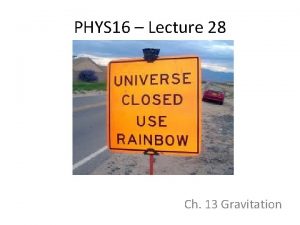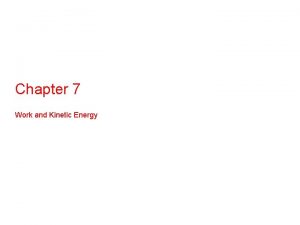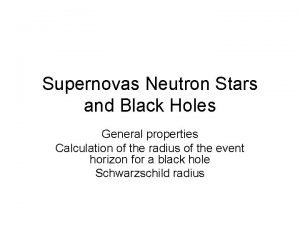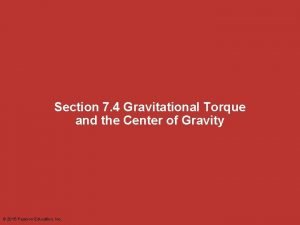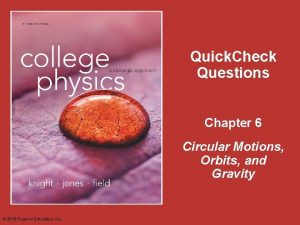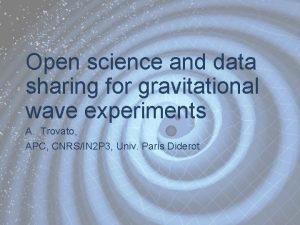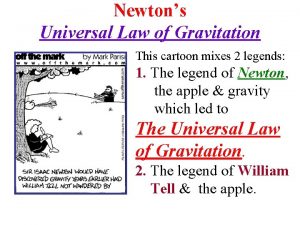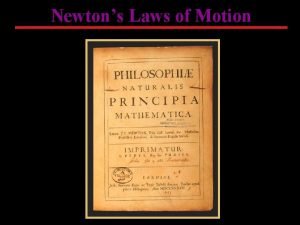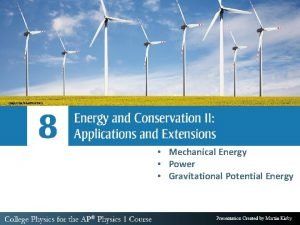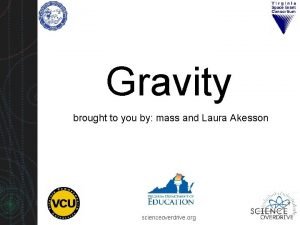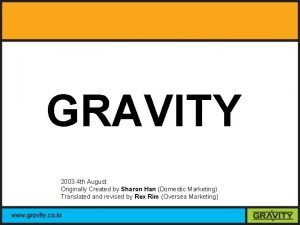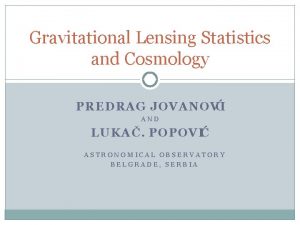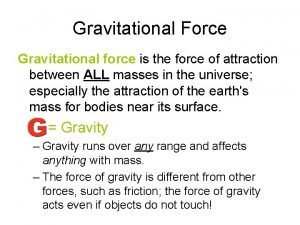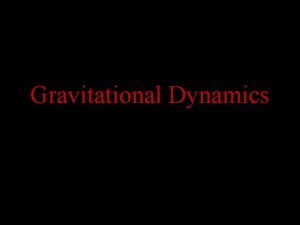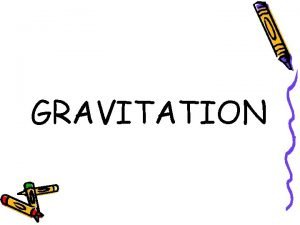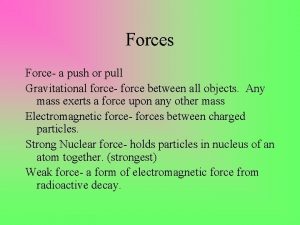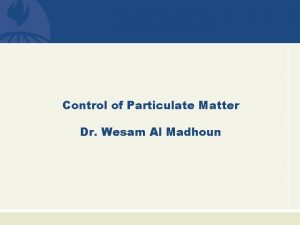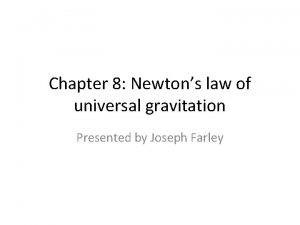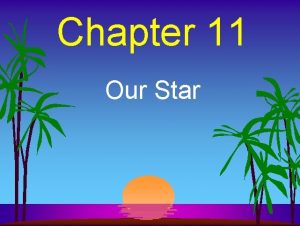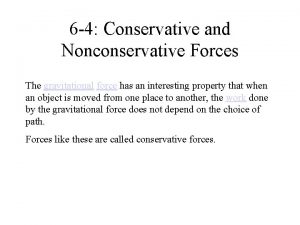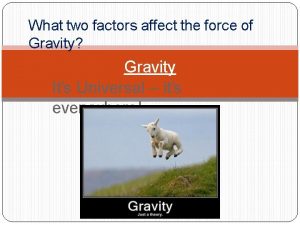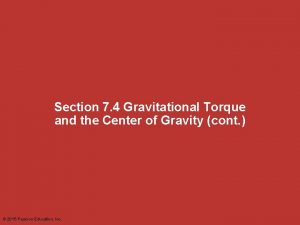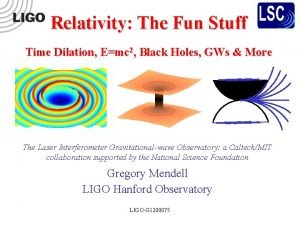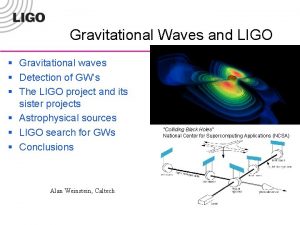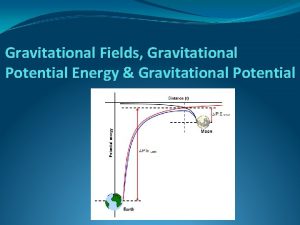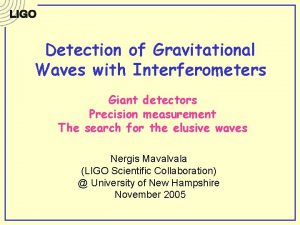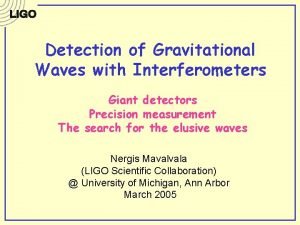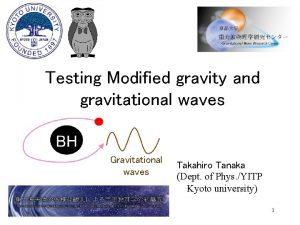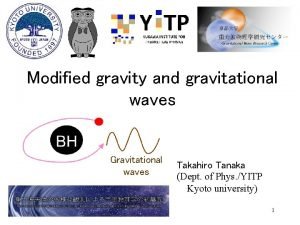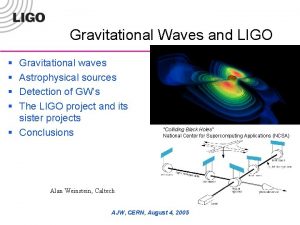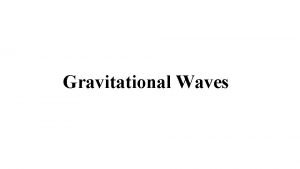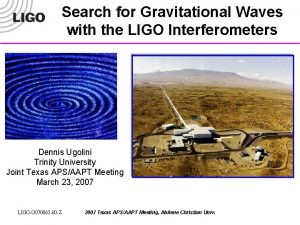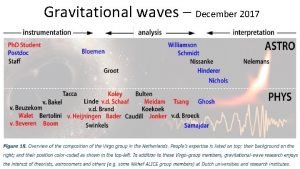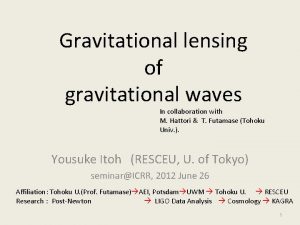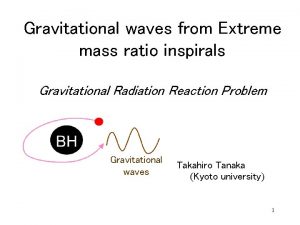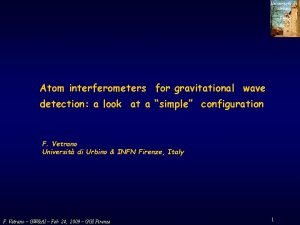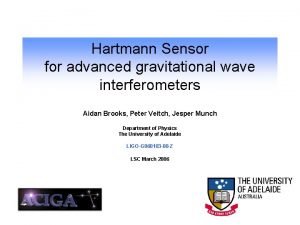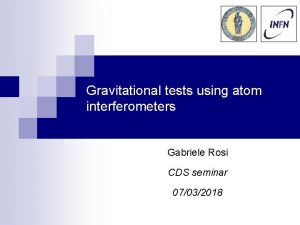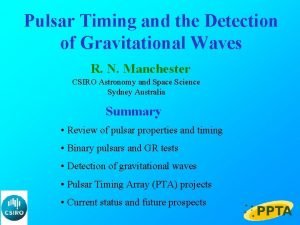Detection of Gravitational Waves with Interferometers and Quantum
















































- Slides: 48

Detection of Gravitational Waves with Interferometers and Quantum Optical Noise Nergis Mavalvala Caltech May 2003 LIGO-G 030252 -00 -R

Global network of detectors GEO LIGO VIRGO TAMA AIGO LIGO-G 030252 -00 -R • Detection confidence • Source polarization • Sky location LISA

Gravitational Waves § General relativity predicts transverse spacetime distortions propagating at speed of light § In TT gauge and weak field approximation, Einstein field equations wave equation § Conservation laws § Conservation of energy no monopole radiation § Conservation of momentum no dipole radiation § Lowest moment of field quadrupole (spin 2) § Radiated by aspherical (“dark) astrophysical objects § Push freely floating masses together and apart LIGO-G 030252 -00 -R

Astrophysics with GWs vs. E&M GW Accelerating charge Accelerating aspherical mass Wavelength small compared Wavelength large compared to sources images no spatial resolution Absorbed, scattered, Very small interaction; dispersed by matter is transparent 10 MHz and up 10 k. Hz and down § Very different information, mostly mutually exclusive § Difficult to predict GW sources based on EM observations LIGO-G 030252 -00 -R

Strength of GWs: e. g. Neutron Star Binary § Gravitational wave amplitude (strain) § For a binary neutron star pair M h ~10 -21 LIGO-G 030252 -00 -R R M r

Principle of Interferometric Measurement § Laser interferometer DL = h L f DL § Suspend mirrors on pendulums “free” mass LIGO-G 030252 -00 -R

Power-recycled Interferometer Optical resonance: requires test masses to be held in position to 10 -10 -10 -13 meter “Locking the interferometer” end test mass Light bounces back and forth along arms ~100 times 30 k. W Light is “recycled” ~50 times 300 W input test mass Laser + optical field conditioning 6 W single mode LIGO-G 030252 -00 -R signal

Initial LIGO Sensitivity Goal § Strain sensitivity < 3 x 10 -23 1/Hz 1/2 at 200 Hz § Displacement Noise § Seismic motion § Thermal Noise § Radiation Pressure § Sensing Noise § Photon Shot Noise § Residual Gas § Facilities limits much lower LIGO-G 030252 -00 -R

LIGO WA 30 (± 30 10 k m m s) 4 km 2 km LA 4 km LIGO-G 030252 -00 -R

LIGO-G 030252 -00 -R

Science Running Plan § Interferometer performance § Intersperse commissioning and data taking consistent with obtaining one year of integrated data at h = 10 -21 by end of 2006 § Astrophysical searches § Two “upper limit” runs S 1 and S 2 (at unprecedented early sensitivity) are interleaved with commissioning § S 1 Aug-Sep 2002 duration: 2 weeks § S 2 Feb-Apr 2003 duration: 8 weeks § First search run (S 3) planned for late 2003 (duration: 6 months) § Finish detector integration & design updates. . . § Engineering "shakedown" runs interspersed as needed § Advanced LIGO-G 030252 -00 -R

Strain Sensitivities During S 1 H 2 & H 1 L 1 3*10 -21 Hz -1/2 @ f ~300 Hz LIGO-G 030252 -00 -R

Analysis working groups Sources § Inspiral § Coalescing compact binaries § Periodic continuous waves § Burst § Triggered § Untriggered § Stochastic § Primordial Big Bang background § Continuum of sources LIGO-G 030252 -00 -R GWs neutrinos photons now

Summary of upper limits for S 1 § Upper limits as presented at AAAS meeting Feb 2003 § Stochastic backgrounds § Upper limit 0 < 72. 4 (H 1 - L 1 pair) Standard Inflation Limit from Big Bang Nucleosynthesis < 10 -5 Prediction < 10 -15 § Neutron star binary inspiral § Range of detectability < 200 kpc (1. 4 – 1. 4 MSUN NS binary with SNR = 8) § Coalescence Rate for Milky Way equivalent galaxy < 164/yr 90% CL § Periodic sources PSR J 1939+2134 at 1283 Hz § GW radiation h < 2 10 -22 90% CL (expect h ~ 10 -27 if pulsar spindown entirely due GW emission) § Burst sources § Upper limit h < 5 10 -17 90% CL § S 2 is ~10 x more sensitive and ~4 x longer LIGO-G 030252 -00 -R

Strain Sensitivity coming into S 2 S 1 6 Jan L 1 LIGO-G 030252 -00 -R

Noise contributions (Sept. 2002) LIGO-G 030252 -00 -R

LIGO Science Has Started § LIGO has started taking data § First science run (S 1) last summer § Collaboration has carried out first analysis looking for ü Bursts ü Compact binary coalescences ü Stochastic background ü Periodic sources § Second science run (S 2) ended few weeks ago § Sensitivity is ~10 x better than S 1 § Duration is ~ 4 x longer § Bursts 4 x lower rate limit & 10 x lower strain limit § Inspirals reach > 1 Mpc -- includes M 31 (Andromeda) § Stochastic background limits on WGW < 10 -2 § Periodic sources limits on hmax ~ few x 10 -23 (e ~ few x 10 -6 @ 3. 6 kpc) LIGO-G 030252 -00 -R

The Task Ahead § Science runs § Upper limits § Scientific searches § Commissioning remaining subsystems § Factor of 10 (above 200 Hz) to 1000 (at 40 Hz) improvement needed to reach design sensitivity § Coupling to environment, e. g. § Earthquakes § Trains twice a day at Livingston § Anthropogenic noise aseismic pre-isolation system § Electronics improvements § Advanced LIGO proposed and R&D well underway LIGO-G 030252 -00 -R

The next-generation detector Advanced LIGO (aka LIGO II) q q Now being designed by the LIGO Scientific Collaboration Goal: q Quantum-noise-limited interferometer q Factor of ten increase in sensitivity q Factor of 1000 in event rate One day > entire 2 -year initial data run q Schedule: q Begin installation: 2007 q Begin data run: 2009 LIGO-G 030252 -00 -R

A Quantum Limited Interferometer Q ua nt um LIGO II n sio en sp l Su rma the ic Seism LIGO-G 030252 -00 -R Tes t ther mass mal

How will we get there? § Seismic noise § Active isolation system § Mirrors suspended as fourth (!!) stage of quadruple pendulums § Thermal noise § Suspension fused quartz; ribbons § Test mass higher mechanical Q material, e. g. sapphire § Optical noise § Input laser power increase to ~200 W § Optimize interferometer response, Tifo signal recycling LIGO-G 030252 -00 -R

Quantum Noise § Measurement process § Interaction of light with test masses § Counting signal photons with a PD § Noise in measurement process § Poissonian statistics of force on test mass due to photons radiation pressure noise (RPN) § Poissonian statistics of counting the photons shot noise (SN) LIGO-G 030252 -00 -R

Strain sensitivity limit due to quantum noise § Shot Noise § Uncertainty in number of photons detected a § (Tunable) interferometer response Tifo depends on light storage time of GW signal in the interferometer § Radiation Pressure Noise § Photons impart momentum to cavity mirrors Fluctuations in the number of photons a LIGO-G 030252 -00 -R

Initial LIGO-G 030252 -00 -R

Standard Quantum Limit in GW Detectors § “Traditional” treatment (Caves, PRD 1980) § Shot noise and radiation pressure noise uncorrelated § Vacuum fluctuations entering output port of the beam splitter interfere with the laser light superpose fluctuations on the light § Optimal Pbs for a given Tifo § Limit to TM position (strain) sensitivity for that optimal power for a given Tifo and frequency § Minimize total quantum noise (quadrature sum of SN and RPN) for a given frequency and power SQL enforced by complementarity of shot noise (Dx) and radiation pressure noise (Dp) due to LIGO-G 030252 -00 -Rvacuum fluctuations entering output port

Optimizing the optical response: Signal Tuning r(l). e Power Recycling Cavity forms compound output coupler with complex reflectivity. Peak response tuned by changing position of SRM l Signal Recycling LIGO-G 030252 -00 -R if (l) Reflects GW photons back into interferometer to accrue more phase

Advance LIGO Sensitivity: Improved and Tunable Thorne… LIGO-G 030252 -00 -R

Signal recycling mirror quantum correlations § Shot noise and radiation pressure (back action) noise are correlated (Buonanno and Chen, PRD 2001) § Optical field (which was carrying mirror displacement information) returns to the arm cavity § Radiation pressure (back action) force depends on history of test mass (TM) motion § Dynamical correlations Part of the light leaks out the SRM and contributes to the shot noise BUT the (correlated) part reflected from the SRM returns to the TM and contributes to the RPN at a later time LIGO-G 030252 -00 -R RPN(t+t) SN(t)

New quantum limits § Quantum correlations § SQL no longer meaningful § Optomechanical resonance (“optical spring”) § Noise cancellations possible § Quantum non-demolition § Evade measurement back-action by measuring of an observable that does not effect a later measurement § Correlations between the SN and RPN quadratures § “Quantum non-demolition for free? ” LIGO-G 030252 -00 -R

Revitalized interest in quantum effects and quantum non-demolition § Ad. LIGO is quantum-noise-limited at almost all frequencies § Signal recycling mirror modified test mass dynamics § Quantum correlations allow for manipulation of quantum noise § Measure a QND observable (with [p(t), p(t’)] = 0) § Squeezing is more readily achieved except § More is better (> 6 d. B) § Not in GW band (10 Hz --10 k. Hz) LIGO-G 030252 -00 -R

Sub-quantum-limited interferometry XQuantum correlations LIGO-G 030252 -00 -R Squeezing X+

Classical Optics - Quantum Optics § Classical optics § Quantum optics § Amplitude § Phase § Power § Annihilation operator § Creation operator § Photon number § Phasor representation § § Length amplitude § Angle phase LIGO-G 030252 -00 -R and not Hermitian NOT observables

Defining Observables § Define a Hermitian operator pair § is the amplitude quadrature operator § is the phase quadrature operator LIGO-G 030252 -00 -R § Linearization § DC term + fluctuations § Fluctuations in amplitude and phase quadratures Mc. Kenzie

Some quantum states of light § Analogous to the phasor diagram § Stick dc term § Ball fluctuations § Common states § § Coherent state Vacuum state Amplitude squeezed state Phase squeezed state LIGO-G 030252 -00 -R Mc. Kenzie

Vacuum State in a Michelson § Michelson on dark fringe laser contributes only correlated noise § GW signal from anticorrelated effect phase quadrature § Vacuum noise couples in at the beamsplitter § Phase quadrature fluctuations: Shot Noise § Amplitude quadrature fluctuations: Radiation Pressure Noise LIGO-G 030252 -00 -R Mc. Kenzie

Squeezed vacuum state in an Interferometer § GW signal in the phase quadrature § Not true for all interferometer configurations § Detuned signal recycled interferometer GW signal in both quadratures -XX ++ XX XX- + X LIGO-G 030252 -00 -R § Orient squeezed state to reduce noise in phase quadrature

QND in Ad. LIGO and beyond § QND interferometers § Manipulation of SN-RPN correlation terms § Manipulation of signal vs. noise quadratures (KLMTV, 2000) § Squeezed vacuum into output port ANU, 2002 § Squeezed light § Increased squeeze efficiency § Non-linear susceptibilities § High pump powers § Internal losses § Squeeze at low (GW) frequencies LIGO-G 030252 -00 -R

If we succeed with squeezing… LIGO-G 030252 -00 -R

Ultimate success… New Instruments, New Field, the Unexpected… LIGO-G 030252 -00 -R

With losses LIGO-G 030252 -00 -R

Production of squeezed light § Non-linear crystals § Optical Parametric Amplification (OPA) § Three wave mixing § Pump (532 nm) § Seed (1064 nm) LIGO-G 030252 -00 -R

OPA Process § Phase dependent § Lines of force § Compresses along phase axis § Stretches along amplitude axis LIGO-G 030252 -00 -R

Squeezing Experimental Schematic LIGO-G 030252 -00 -R

Proposed squeezing experiment LIGO-G 030252 -00 -R

Squeezed State in a Michelson § GW signal in the phase quadrature § Not true for all interferometer configurations § Detuned signal recycled interferometer GW signal in both quadratures § Orient squeezed state to reduce noise in phase quadrature LIGO-G 030252 -00 -R Mc. Kenzie

Squeezed State in a Michelson § Inject squeezed state into the dark port of Michelson to replace vacuum § Amplitude squeezed state oriented to reduce noise in the signal (phase) quadrature LIGO-G 030252 -00 -R Mc. Kenzie

Squeezed source wish list § 10 d. B § Internal losses § Injection losses § c(2) and c(3) nonlinearities § Pump power § Photodetection efficiency LIGO-G 030252 -00 -R § 100 Hz § Reduce noise in parametric oscillator § Correlate multiple squeezed beams

Heisenberg and QND § Heisenberg Uncertainty Principle § Measure position of a particle very precisely § Its momentum very uncertain § Measurement of its position at a later time uncertain since § Quantum non-demolition (QND) § Evade measurement back-action by measuring of an observable that does not effect a later measurement § Good QND variables (observables) § Momentum of a free particle since [p, H] = 0 § Quadrature components of EM field LIGO-G 030252 -00 -R
 Matched filtering gravitational waves
Matched filtering gravitational waves Gravitational waves
Gravitational waves Gravitational waves
Gravitational waves Gravitational waves
Gravitational waves Gravitational waves
Gravitational waves Compare and contrast p waves and s waves using venn diagram
Compare and contrast p waves and s waves using venn diagram Quantum physics vs mechanics
Quantum physics vs mechanics Quantum physics vs mechanics
Quantum physics vs mechanics What waves do not require a medium
What waves do not require a medium Mechanical wave examples
Mechanical wave examples What is a rainbow
What is a rainbow Short wave vs long wave radiation
Short wave vs long wave radiation Difference between matter waves and electromagnetic waves
Difference between matter waves and electromagnetic waves Mechanical and electromagnetic waves similarities
Mechanical and electromagnetic waves similarities Seismic waves
Seismic waves Electromagnetic and mechanical waves
Electromagnetic and mechanical waves Constructive waves and destructive waves difference
Constructive waves and destructive waves difference Longitudinal wave vs transverse wave
Longitudinal wave vs transverse wave The wave chapter 13
The wave chapter 13 Sound waves longitudinal waves
Sound waves longitudinal waves Mechanical waves vs electromagnetic waves
Mechanical waves vs electromagnetic waves Seismic waves are mechanical waves
Seismic waves are mechanical waves Kinetic energy gravitational
Kinetic energy gravitational Centripetal force and gravitational force
Centripetal force and gravitational force Normal force and gravitational force
Normal force and gravitational force Escape velocity of neutron star
Escape velocity of neutron star Gravitational torque formula
Gravitational torque formula Gravitational force quick check
Gravitational force quick check Gravitational wave open science center
Gravitational wave open science center Cartoon law of universal gravitation
Cartoon law of universal gravitation Inertial mass vs gravitational mass
Inertial mass vs gravitational mass Gravitational potential energy equation
Gravitational potential energy equation Gravitational mass vs inertial mass
Gravitational mass vs inertial mass Gravitational field ragnarok
Gravitational field ragnarok Gravitational lensing
Gravitational lensing Effect of gravitational force
Effect of gravitational force Gravitational dynamics
Gravitational dynamics Gravitational phenomena
Gravitational phenomena Gravitational force push or pull
Gravitational force push or pull Gravitational settling chamber
Gravitational settling chamber Wesam al madhoun
Wesam al madhoun Inertial mass vs gravitational mass
Inertial mass vs gravitational mass Gravitational equilibrium
Gravitational equilibrium Gravitational settling chamber
Gravitational settling chamber The force of gravitation is conservative or nonconservative
The force of gravitation is conservative or nonconservative Gravitational potential energy
Gravitational potential energy What two factors affect gravity
What two factors affect gravity Gravitational torque calculator
Gravitational torque calculator Time dilation equation
Time dilation equation
